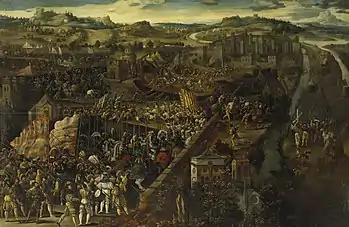Visconti Park
The Visconti Park or Parco Visconteo is an area in Lombardy, northern Italy, between Pavia and Certosa di Pavia of about 2,200 hectares (22 km2) corresponding to what was once the private park of the Visconti family, lords and dukes of Milan.
The original park
The park was initially conceived as part of the project of the Pavia castle, built after 1360 by decision of Galeazzo II Visconti. To the same period goes back the idea to reserve a large area, north to the castle, to the private leisure and hunting of the Visconti family. Thirty years later Gian Galeazzo Visconti added a further portion of land (Parco Nuovo, the New Park) to the first part (Parco Vecchio, the Old Park). With this extension the park reached to the north the Charterhouse of Pavia founded few years before by the Visconti as well with the purpose to host the family mausoleum.[1]
The park was encircled by walls and accessible by gates. The total length of the wall along the perimeter of the park is estimated to be about 25 km. Inside the park manors, farmsteads, ponds with hydraulic arrangements and pathways were built. At its center the Mirabello Castle, seat of the Captain of the Park, was erected. In some part the vegetation was designed with recreational purposes or to accommodate animal species either autoctone or exotic. In other parts the agricultural activities were maintained in continuity with the external areas.[2]
The original Visconti Park is considered an archetype of the modern parks as an area set aside by local authorities and modified with techniques of landscape architecture. In its hunting purposes it can be compared to the English deer parks. The complex of the Visconti Park, the Pavia castle and the Certosa di Pavia constitutes the first example in Europe of a royal palace connected to an enclosed park with a private chapel or other buildings. The nearest example visible today is the royal villa and park of Monza realized about four centuries later.
Disuse and decay

After the rule of Ludovico Maria Sforza (1489-1494) the park was progressively abandoned and its features deteriorated. In 1525 it was the theater of the Battle of Pavia fought between French and Imperial–Spanish forces. The walls of the park were damaged by the armies while manoeuvring during the battle. In the following centuries the masonry of the wall, offering bricks for the reuse in the nearby peasant houses, went through a general demise up to its complete demolition.
The park nowadays
The Visconti Park today has few signs of the original features, being mainly dedicated to agriculture like the area external to it. Of the Mirabello Castle, having originally a quadrilater layout, only one side has survived. Remains of two gates are visible at Torre del Mangano and in San Genesio (Porta Pescarina). The other gates survive only in place names. To facilitate the visit of the park, bike routes and thematical tours are proposed by local authorities.[3][4]
References
- Vicini, Donata (1988). Pavia e Certosa: guida storico-artistica (in Italian). Pavia: Azienda di promozione turistica di Pavia.
- Erba, Luisa (2005). Giardini a Pavia: principeschi, monastici, effimeri, magici, segreti (in Italian). Roma: Gangemi. ISBN 9788849207569.
- "il parco visconteo" (PDF) (in Italian). Pavia. Retrieved March 3, 2018.
- "il parco visconteo - map" (PDF) (in Italian). Pavia. Retrieved March 3, 2018.
.svg.png.webp)